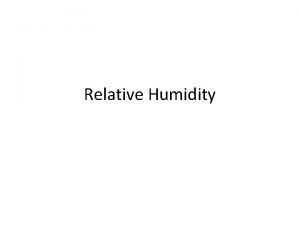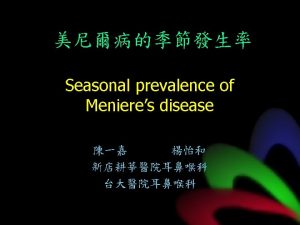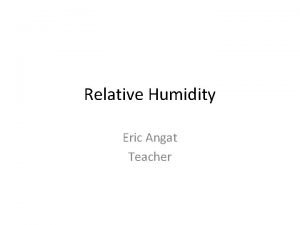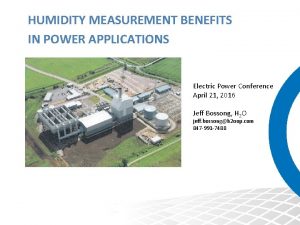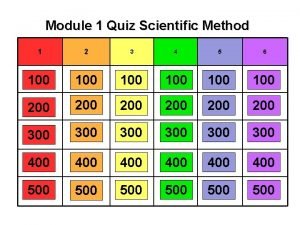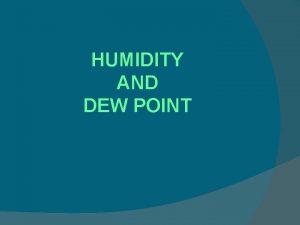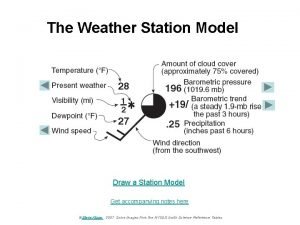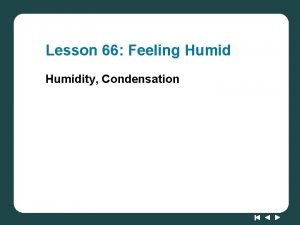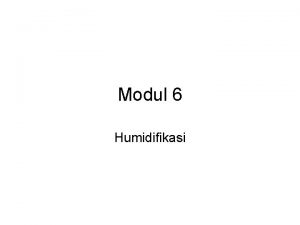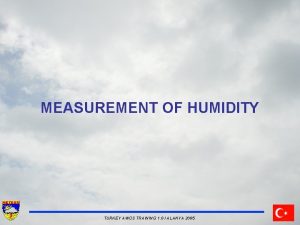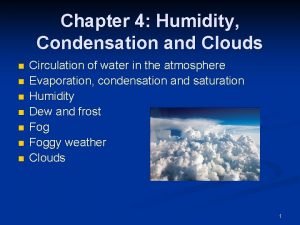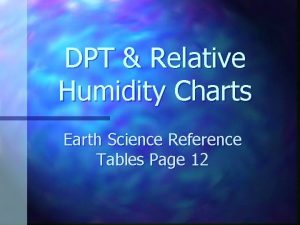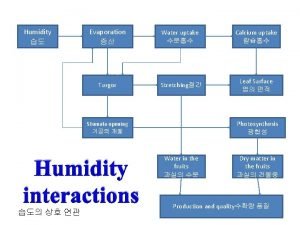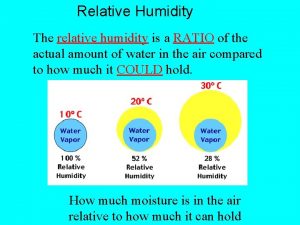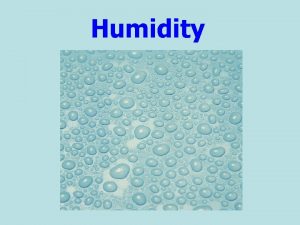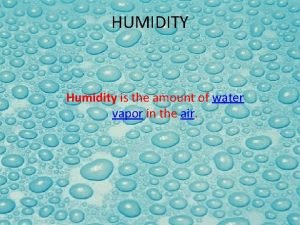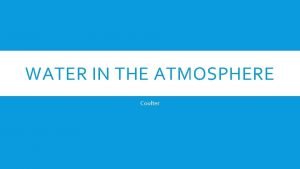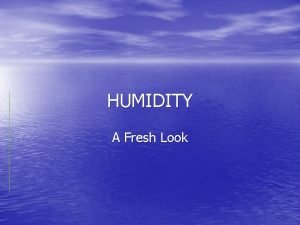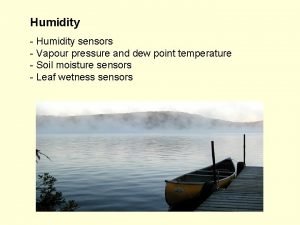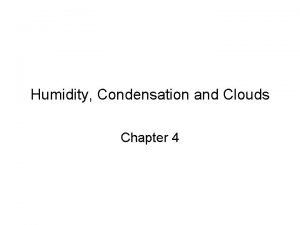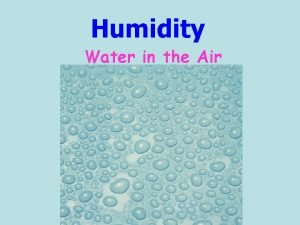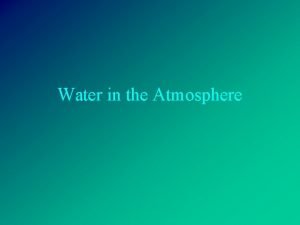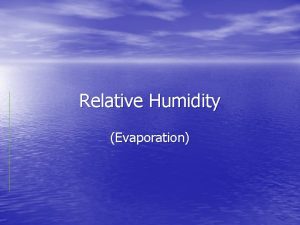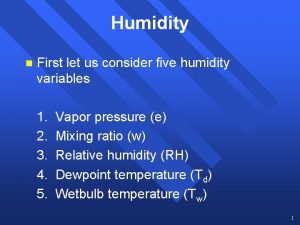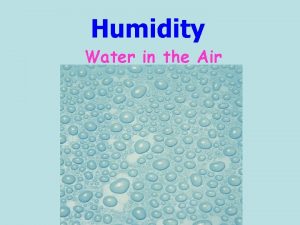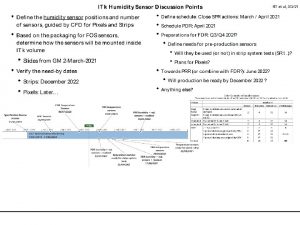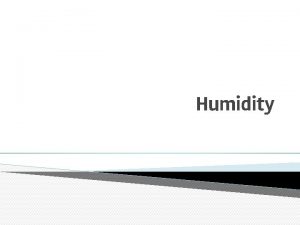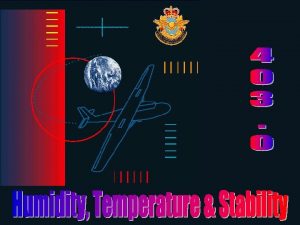Humidity is A measure of the amount of



















- Slides: 19

Humidity is: • A measure of the amount of water in the air • Water is added to the air by the process of EVAPORATION.

Relative Humidity • RELATIVE HUMIDITY is the amount of water in the air compared to the amount of water the air could possibly hold. • Humidity values are usually given as Relative Humidity. – Examples: – if the air is holding half the water it could hold, it’s Relative Humidity is 50%. – If the air is holding ALL the water it can hold it is saturated and the relative humidity is 100% – If the air is holding no water, relative humidity is 0% – If it holding a quarter of the water it could hold, 25%

What temperature can hold more water vapor?

Saturation • If the air is SATURATED, it is holding ALL of the water that it can hold. – WARM air expands and can hold more water vapor than COLD air, so it takes more water to saturate warm air. If the air is saturated, its Relative Humidity is 100%, and if the temperature drops PRECIPITATION will occur.

Factors that Affect Relative Humidity 1. Amount of water: If you increase the amount of water in the air (by adding it due to evaporation), Relative humidity will go up. 2. Temperature: Since warm air can hold more water than cold air, if you lower the temperature the Relative Humidity will go up, even if you don’t add more water.

Water capacity of air at different temperatures

Measuring Humidity • Relative Humidity is measured using a PSYCHROMETER. – A psychrometer is made of two thermometers. One is covered with a wet cloth. When air moves over the wet cloth, evaporation occurs and lowers the temperature on that thermometer. If you compare the temperature on the two thermometers you can get the relative humidity.


Ex. 1 Dry Bulb = 14 degrees C Wet Bulb = 10 degrees C Difference is 14 -10 = 4 1 st – look at dry bulb reading (14) 2 nd – find difference (4) 3 rd – RH is where they meet = 60%

Ex. 3 Dry Bulb = 6 degrees C Wet Bulb = 6 degrees C Difference is 6 -6 = 0 RH = 100%

Forms of Condensation • Condensation • Dew • The change from vapor to a liquid-usually happens in the atmosphere. • Has to do with the airs humidity and temperature. • If the water vapor condenses on surfaces such as grass, in the form of a liquid, it is called dew.


• Dew Point • Condensation • The temperature at which saturation occurs. • Dew point can be at different temps. It depends on the amount of water vapor in the air. • The more water vapor the air starts with the higher its dew point. • In order for condensation to occur there are two requirements. • Cooling and Nuclei. • Cooling can happen in 4 different ways. – – 1. Contacting a colder surface 2. Radiating heat 3. Mixing with colder air 4. Expanding when it rises

• Condensation Nuclei (CN) • Water vapor needs to condense on something. The tiny particles that water can condense on in the air are CN. • CN are usually substances such as salt, sulfate particles, or nitrate particles. • The sulfates and nitrates come from natural sources and from burning of fuels. • Salt enters the air by fine sea spray.

• Frost • When the temp of the air is below 0 degrees C then the water vapor condenses as a solid. • -2 degrees C, liquid in the cells of some plants may freeze. • This freezing bursts the cell walls and kills the plants. • What causes killing frosts? ? ? • Killing frosts are not caused by the air temp but rather by the temperature of the plant.


• Fogs • Ground Fogs or Radiating fog • Advection fog • Often a surface layer of air a few hundred meters thick is cooled below the dew point. As water vapor condenses throughout the entire layer, tiny droplets fill the air and form fog. • Form under conditions similar to those that form dew. • When the nighttime sky clears and the ground loses heat rapidly by radiation. If Light breezes mix the air. The whole layer of air is cooled below the dew point and fog forms. • This happens near rivers and streams during fall and winter months. . • Results when warm, moist air blows over a cool surface.


 A measure of the amount of solute dissolved in a solvent
A measure of the amount of solute dissolved in a solvent Gibbons jacobean city comedy download
Gibbons jacobean city comedy download Air temperature
Air temperature Humidity server room
Humidity server room What is humidity
What is humidity Humidity and meniere's disease
Humidity and meniere's disease Dew point comfort chart
Dew point comfort chart Humidity 2 optimization
Humidity 2 optimization Three redwood trees are kept at different humidity levels
Three redwood trees are kept at different humidity levels Which statement accurately describes humidity?
Which statement accurately describes humidity? High humidity meaning
High humidity meaning Station model weather symbols
Station model weather symbols What is humidity
What is humidity Contoh soal humidity
Contoh soal humidity Humidity monitor turkey
Humidity monitor turkey Relativ humidity
Relativ humidity Earth science reference table relative humidity
Earth science reference table relative humidity Humidity evaporation
Humidity evaporation Station model
Station model Relative humidity
Relative humidity




